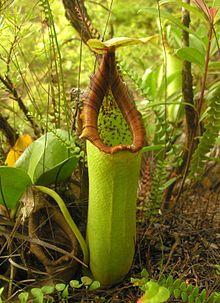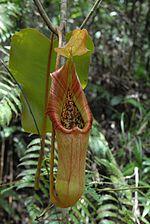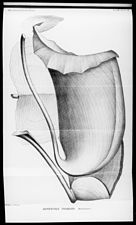| Nepenthes truncata | |
|---|---|
 | |
| A pitcher of N. truncata found in northern Mindanao at an elevation of 230 m | |
| Scientific classification | |
| Kingdom: | Plantae |
| Clade: | Tracheophytes |
| Clade: | Angiosperms |
| Clade: | Eudicots |
| Order: | Caryophyllales |
| Family: | Nepenthaceae |
| Genus: | Nepenthes |
| Species: | N. truncata |
| Binomial name | |
| Nepenthes truncata | |
| Synonyms | |
| |
Nepenthes truncata (/nɪˈpɛnθiːz trʌŋˈkɑːtə/; from Latin truncatus "terminating abruptly") is a tropical pitcher plant endemic to the Philippines. It is known from the islands of Dinagat, Leyte, and Mindanao.[3] The species grows at an elevation of 0–1500 m above sea level.[4] Nepenthes truncata is characterised by its heart-shaped (truncate) leaves and very large pitchers, which can reach up to 40 cm in height.
Nepenthes robcantleyi was once considered a dark, highland form of this species.[5][6]
Carnivory
On September 29, 2006, at the Botanical Gardens in Lyon, France, a Nepenthes truncata was photographed containing the decomposing corpse of a mouse. This incident is the first record of a mammal being successfully trapped in the pitchers of N. truncata indoors. Both N. rajah [7] and N. rafflesiana[8] are known to occasionally catch small mammals in the wild. Although it is possible for Nepenthes truncata to trap mice, the calcium heavy bones will not be digested.
An epiphytic N. truncata from the Pantaron Range near San Fernando
Illustration of N. truncata from Macfarlane's type description of 1911
Natural hybrids
- N. alata × N. truncata [=N. × truncalata][9]
- N. mindanaoensis × N. truncata[4]
- ? N. petiolata × N. truncata[10][11]
References
- ^ Clarke, C.M.; Cantley, R.; Nerz, J.; Rischer, H.; Witsuba, A. (2000). "Nepenthes truncata". IUCN Red List of Threatened Species. 2000: e.T39708A10257507. doi:10.2305/IUCN.UK.2000.RLTS.T39708A10257507.en.
- ^ Macfarlane, J.M. 1911. New species of Nepenthes. Contributions from the Botanical Laboratory of the University of Pennsylvania 3(3): 207–210. (plates I–II)
- ^ McPherson, S.R. & V.B. Amoroso 2011. Field Guide to the Pitcher Plants of the Philippines. Redfern Natural History Productions, Poole.
- ^ a b McPherson, S.R. 2009. Pitcher Plants of the Old World. 2 volumes. Redfern Natural History Productions, Poole.
- ^ Cheek, M. 2011. Nepenthes robcantleyi sp. nov. (Nepenthaceae) from Mindanao, Philippines. Nordic Journal of Botany 29(6): 677–681. doi:10.1111/j.1756-1051.2011.01449.x
- ^ Mey, F.S. 2011. Nepenthes robcantleyi aka "Nepenthes black truncata". Strange Fruits: A Garden's Chronicle, December 27, 2011.
- ^ Phillipps, A. 1988. "A second record of rats as prey in Nepenthes rajah" (PDF). (203 KiB) Carnivorous Plant Newsletter 17(2): 55.
- ^ Moran, J.A. 1991. The role and mechanism of Nepenthes rafflesiana pitchers as insect traps in Brunei. Ph.D. thesis, University of Aberdeen, Aberdeen, Scotland.
- ^ Mann, P. 1998. A trip to the Philippines. Carnivorous Plant Newsletter 27(1): 6–11.
- ^ Kurata, S. & M. Toyoshima 1972. Philippine species of Nepenthes. The Gardens' Bulletin Singapore 26(1): 155–158. Abstract Archived 2011-07-22 at the Wayback Machine
- ^ Cheek, M.R. & M.H.P. Jebb 2001. Nepenthaceae. Flora Malesiana 15: 1–157.
Carnivorous plant resource. 2019.[1]
Further reading
- Bauer, U., C.J. Clemente, T. Renner & W. Federle 2012. Form follows function: morphological diversification and alternative trapping strategies in carnivorous Nepenthes pitcher plants. Journal of Evolutionary Biology 25(1): 90–102. doi:10.1111/j.1420-9101.2011.02406.x
- Cantley, R. 2000. Nepenthes of the Philippines. [video] The 3rd Conference of the International Carnivorous Plant Society, San Francisco, USA.
- Cheek, M. & M. Jebb 2014. Expansion of the Nepenthes alata group (Nepenthaceae), Philippines, and descriptions of three new species. Blumea 59: 144–154. doi:10.3767/000651914X685861
- Clarke, C. & J.A. Moran 2011. Incorporating ecological context: a revised protocol for the preservation of Nepenthes pitcher plant specimens (Nepenthaceae). Blumea 56(3): 225–228. doi:10.3767/000651911X605781
- Co, L. & W. Suarez 2012. Nepenthaceae. Co's Digital Flora of the Philippines.
- Elmer, A.D.E. 1915. Nepenthaceae. [pp. 2785–2787] In: Two hundred twenty six new species—II. Leaflets of Philippine Botany 8: 2719–2883.
- (in German) Gronemeyer, T. 2008. Nepenthes auf den Philippinen – Ein Reisebericht. Das Taublatt 60(1): 15–27.
- Kurup, R., A.J. Johnson, S. Sankar, A.A. Hussain, C.S. Kumar & S. Baby 2013. Fluorescent prey traps in carnivorous plants. Plant Biology 15(3): 611–615. doi:10.1111/j.1438-8677.2012.00709.x
- Macfarlane, J.M. 1927. The Philippine species of Nepenthes. The Philippine Journal of Science 33(2): 127–140.
- (in Indonesian) Mansur, M. 2001. "Koleksi Nepenthes di Herbarium Bogoriense: prospeknya sebagai tanaman hias" (PDF). Archived from the original (PDF) on 2012-03-19. In: Prosiding Seminar Hari Cinta Puspa dan Satwa Nasional. Lembaga Ilmu Pengetahuan Indonesia, Bogor. pp. 244–253.
- (in German) McPherson, S. & T. Gronemeyer 2008. Die Nepenthesarten der Philippinen Eine Fotodokumentation. Das Taublatt 60(1): 34–78.
- Meimberg, H., A. Wistuba, P. Dittrich & G. Heubl 2001. Molecular phylogeny of Nepenthaceae based on cladistic analysis of plastid trnK intron sequence data. Plant Biology 3(2): 164–175. doi:10.1055/s-2001-12897
- (in German) Meimberg, H. 2002. "Molekular-systematische Untersuchungen an den Familien Nepenthaceae und Ancistrocladaceae sowie verwandter Taxa aus der Unterklasse Caryophyllidae s. l." (PDF). Ph.D. thesis, Ludwig Maximilian University of Munich, Munich.
- Meimberg, H. & G. Heubl 2006. Introduction of a nuclear marker for phylogenetic analysis of Nepenthaceae. Plant Biology 8(6): 831–840. doi:10.1055/s-2006-924676
- Meimberg, H., S. Thalhammer, A. Brachmann & G. Heubl 2006. Comparative analysis of a translocated copy of the trnK intron in carnivorous family Nepenthaceae. Molecular Phylogenetics and Evolution 39(2): 478–490. doi:10.1016/j.ympev.2005.11.023
- Rasco, E.T. Jr. & M.A.D. Maquilan 2005. Initial studies on in vitro germination and early seedling growth of Nepenthes truncata Macf.. Carnivorous Plant Newsletter 34(2): 51–55.
- Rasco, E.T. Jr., G.K.R. Oguis & C.S.C. Silvosa 2012. In vitro rooting of Nepenthes truncata Macf.. Carnivorous Plant Newsletter 41(4): 135–139.
- Renner, T. & C.D. Specht 2011. A sticky situation: assessing adaptations for plant carnivory in the Caryophyllales by means of stochastic character mapping. International Journal of Plant Sciences 172(7): 889–901. doi:10.1086/660882
- Siegara, A. & Yogiara 2009. Bacterial community profiles in the fluid of four pitcher plant species (Nepenthes spp.) grown in a nursery. Microbiology Indonesia 3(3): 109–114.
- Silvosa, C.S.C., E.T. Rasco Jr. & M.A.D. Maquilan 2013. Agricultural waste materials as component of organic potting media for the endangered Nepenthes truncata Macf. (Philippine pitcher plant). Carnivorous Plant Newsletter 42(2): 47–56.
- (in Czech) Svítek, M. 2002. Portréty rostlin - Nepenthes truncata (Macf.) syn. Nepenthes megamphora (Merr. & Quis). Trifid 2002(1): 37–39. (page 2, page 3)
- Exploration of Mount Anipahan and Mount Kiamo. [video] Redfern Natural History Productions.
- WGAL News: Carnivorous Plant Eats Mouse at French Garden




